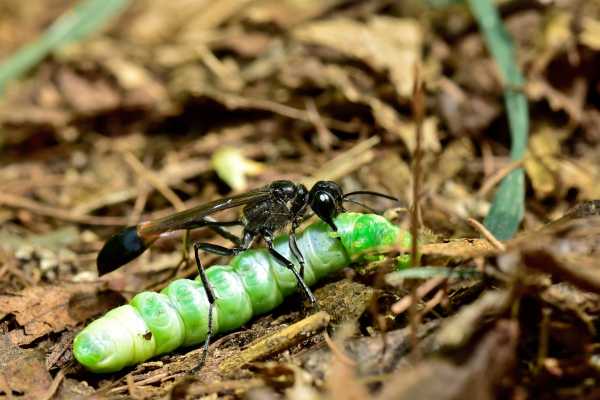Most Docile Wasp?
Hi
Can you tell me which is the most docile wasp?
Don, USA
For some people, wasps are an insect to be feared due to a strong association with stings.
But recently, I have been interested to note that perceptions of wasps are gradually changing, with a recognition that some wasps are not aggressive, and/or stings are unlikely.
Furthermore, wasps perform a vital role in the ecosystem.
So Which Species Of Wasp Are The Most Docile?
It depends how we define ‘docile’ within the context of wasps, but for the purposes of this article, let’s assume it might be judged relating to to:
- The inability to sting or not.
- Being less likely to sting or exhibit territorial or defensive stinging behaviour.
- Possessing a sting that has a very low pain score (as judged by humans)
Of course, of the many wasps in the world, it is actually difficult to be accurate about the "most docile” wasp species over all, since we do not have data on all species, and no doubt, there are (as with bees) likely to be many wasp species as yet undiscovered.
However, we can perhaps reference those species that could arguably be considered ‘docile’ in comparison with other species studied.
The Ability To Sting
Stinging wasps belong to the category known as ‘Aculeata’. However, Aculeata make up only about 30% of described wasp species1 , and the rest are parasitoids1 .
 Parasitoid wasp attacking a target caterpillar host
Parasitoid wasp attacking a target caterpillar hostParasitoid
wasps total more than 70,000 non-stinging wasp species1 .
The roles of parasitoid wasps in the regulation of agricultural pests are well recognised1 .
 Parasitoid wasp with caterpillar host
Parasitoid wasp with caterpillar host‘Aggressive’
Behaviour
Some defensive behaviours by wasps are deemed (by humans) as aggressive or threatening, because they might result in a stinging incident.
Within the aculeate (stinging wasp) group, solitary wasp species are less likely to exhibit ‘aggressive’ behaviours and stinging behaviour than social wasps.
In general, solitary wasp species might therefore, be considered ‘more docile’ than social wasps,.
It should be noted that what humans deem to be ‘aggressive’ behaviours tend to be defensive, either of self, territory, food or colony.
But why would solitary wasp species be considered more docile than social species?
The reason social species may exhibit ‘aggressive’ behaviours is because social wasp colonies (in contrast with solitary species):
- have ‘defence power’ provided by the many individuals living in the colony;
- have a large food store and many young, thus facilitating defensive instincts
- there may be in greater competition for resources. The many mouths to feed within the colony creates competition for food resources and suitable nest sites, thereby fostering territorial behaviour.
What this means is that as far as humans are concerned, in contrast with solitary wasps, social wasps could exhibit defensive behaviours around feeding areas (including picnics!), around their nests, and of course, when individually ‘threatened’ (such as being swatted).

Least Painful Wasp Sting?
Of the aculeate species, which had the least painful sting?
Elsewhere on this website, I have discussed the work of Justin O. Schmidt, (author of Sting Of The Wild), who compared the stings of a number of insect species, and ranked them for pain, where a score of 4 was considered the most painful, versus the score of 1 which was the least painful.
Despite the study being fairly extensive, and including 58 bee, hornet and wasp species (and it’s worth noting that in his study3 Schmidt submitted himself as a test subject upon which real life insect stings were experienced and assessed!), at the same time, there are approximately 1030001 to 112,0002 species of wasp in the world, so clearly it’s impossible to state for sure which single species is the most docile’ where sting is concerned.
At best, we can surmise that according to a study, there were some wasp species included within the study that deliver a more painful or a relatively benign sting, and the species Sapyga pumila (club-horned wasp) that had the least painful sting of all.
You can read more about this on my page: Bee Vs Wasp Vs Hornet Stings.
References
1. Brock, R.E., Cini, A. and Sumner, S. (2021), Ecosystem services provided by aculeate wasps. Biol Rev, 96: 1645-1675. https://doi.org/10.1111/brv.12719
2. Louis Nastasi, Dr. Nicole Gunter, Associate Curator of Invertebrate Zoology: The Wonderful World of Wasps | Cleveland Museum of Natural History (cmnh.org) THE WONDERFUL WORLD OF WASPS - They Do More Than Just Plague Our Picnics; Cleveland Museum of Natural History.
3. Schmidt JO. Pain and Lethality Induced by Insect Stings: An Exploratory and Correlational Study. Toxins (Basel). 2019;11(7):427. Published 2019 Jul 21.

